文章信息
- 张安盛, 于毅, 庄乾营, 宋亚秋, 彭宗英, 周仙红, 李丽莉, 门兴元
- ZHANG Ansheng, YU Yi, ZHUANG Qianying, SONG Yaqiu, PENG Zongying, ZHOU Xianhong, LI Lili, MEN Xingyuan
- 光谱和光强度对棕榈蓟马雌成虫行为反应的影响
- Effect of spectral sensitivity and intensity on the behavioral response of the Thrips palmi female adult
- 生态学报, 2015, 35(11): 3555-3561
- Acta Ecologica Sinica, 2015, 35(11): 3555-3561
- http://dx.doi.org/10.5846/stxb201308112058
-
文章历史
- 收稿日期:2013-08-11
- 网络出版日期:2014-06-12
棕榈蓟马(Thrips palmi)属缨翅目(Thysanoptera)、蓟马科(Thripidae),喜食茄科、葫芦科等多种蔬菜[1],还传播番茄斑萎病毒等病毒病,严重影响蔬菜的产量和质量[2]。棕榈蓟马最早于20世纪20年代在印度尼西亚被发现[3],70年代以后先后在亚洲、澳洲、美洲和非洲等多个国家和地区发生危害[4, 5]。在我国,棕榈蓟马于20世纪70年代在广州首次被发现后[6],相继在在浙江、江苏、上海、北京等地多种蔬菜上发生危害[7],是我国蔬菜尤其是北方设施蔬菜重要害虫[8]。当前对棕榈蓟马的研究,主要集中在其生物学习性[9, 10, 11, 12, 13]、田间种群动态[14, 15, 16, 17]、空间分布特征[17, 18, 19, 20]和综合治理[16, 21, 22, 23, 24, 25, 26, 27, 28]等方面。对于该害虫的防治,应该在预测预报的基础上,综合应用农业、物理、生物、化学等防治技术,将其控制在经济阈值之内。
许多昆虫具有不同程度的趋光性,并对光的波长具有选择性;色板和灯光诱杀是害虫防治的重要措施[29]。国内外学者对蓟马类害虫的光敏感性开展了一定的研究:范凡等研究了波长和光强度因素对西花蓟马雌虫的趋光行为的影响,明确了西花蓟马雌成虫的趋光率和避光率较高的单色光,探明了光强对西花蓟马雌成虫趋光和避光行为的影响[30];Matteson N等通过视网膜电位技术研究西花蓟马趋光行为[31];Yudin L S等、Vernon R S等、肖长坤等、吴青君等阐明了不同颜色粘卡对田间西花蓟马的诱集效果[32, 33, 34, 35];陈华平等则开展了不同颜色粘卡对田间棕榈蓟马的诱捕试验[27],但只是在田间筛选出对棕榈蓟马有较好诱捕作用的粘卡,没有从根本上揭示波长和光强度因素对棕榈蓟马成虫行为反应的影响。本文应用光行为学方法,研究了棕榈蓟马雌成虫对单色光和白光及其不同光强度的光反应行为差异,试图揭示光源特征与其趋光性间的内在联系,以期为研发针对棕榈蓟马的高效测报和绿色、保护天敌的选择性诱杀(或驱避)光源或光活性物质提供科学依据。
1 材料与方法 1.1 供试虫源供试棕榈蓟马雌成虫采自济南市商河县玉皇庙街道办事处西真村日光温室菜椒。室内在糖果瓶中用新鲜芸豆饲养1周后,选取健壮雌成虫作为供试虫源。饲养条件:温度(27±1)℃,相对湿度60%—70%,光周期为16 h∶8 h。
1.2 试验设置 1.2.1 光源150W的高压氙灯。
1.2.2 光路系统参照魏国树等[36]。光路系统包括石英玻璃隔热片(滤去红外线);一组干涉滤光片(获得单色光);中性滤光片及中性楔形滤光片(调节光强度);石英透镜的聚光镜(使平行光会聚于行为试验箱入光口处的焦平面)。
1.2.3 行为反应装置参照魏国树等[36]。趋光行为装置(图 1)分为3 个部分,即趋光室、避光室和栖息活动室(各活动室长、宽、高分别为8 cm、8 cm、7 cm)。挡光板位于栖息活动室中间,在光路上隔开并将栖息活动室均匀的分成两部分,等面积与趋光室、避光室相接,相接处设有推拉挡板,以保证光照处理时,试虫可自由选择进入趋光室或避光室。
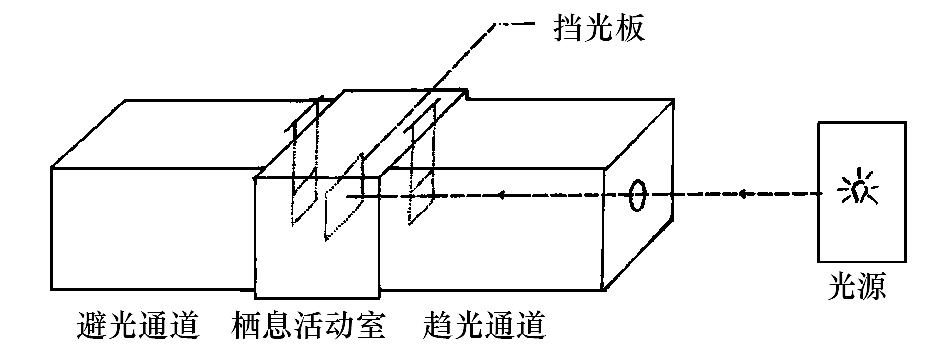
|
| 图 1 趋光行为反应装置 Fig.1 The sketch map of light-path in phototaxis behavior experiment |
供试单色光的波长分别为340、360、380、400、420、440、460、483、498、524、538、562、582和605 nm。自150 W高压氙灯发出的光首先经石英隔热玻璃滤掉红外光,而后通过一组干涉滤光片和中性滤光片得到某一单色光,再经过一石英透镜使光束会聚于行为试验箱的入光口处。为消除不同干涉滤光片对各单色光光强衰减的差异,实验前采用热敏光电耦合照度计和检流计进行测量,用中性楔形滤光片调节各单色光光强度相等(光强对数值logI=0.5)。
1.3.2 光强试验在光谱试验基础上,分别选取棕榈蓟马雌成虫趋光率、避光率较高的单色光以及白光做供试光。单色光和白光的光强度分别用中性滤光片、中性楔形滤光片按一定比例衰减(光强按其对数值(log I)渐次衰减,log I等级依序为0、0.5、1.0、1.5、2.0、2.5、3.0、3.5、4.0、4.5),白光不衰减时的光强约为3.1lx,单色光不衰减时的光强约为0.17lx。用手动快门调节入光口的进光量。相对刺激光强度采用热敏光电耦合照度计和检流计标定。
1.3.3 试虫处理试验在暗室中进行,室内温度(27±0.5)℃,相对湿度(60±5)%。为使棕榈蓟马复眼适应状态一致,每次光刺激前,在暗室中适应2 h。
将在暗室中适应后的棕榈蓟马雌成虫置于行为反应箱的栖息室中,每次光刺激时间为20 min,各处理间隔5 min。每处理重复5次,每次40 头(试虫不重复利用)。在各波长或光强处理后,红光灯下分别统计趋光室和避光室的试虫个数,计算其趋、避光反应率:
趋光率=趋光反应室虫数/总虫数×100%
避光率=避光反应室虫数/总虫数×100%
2 结果与分析 2.1 光谱行为反应在340—605 nm波谱内单色光刺激下,棕榈蓟马雌成虫的光谱趋、避光反应见表 1、图 2。试验结果表明:供试单色光均能引发棕榈蓟马雌成虫的趋、避光反应,其光谱趋、避光行为曲线均为多峰型,各峰间大小差异明显,且同一单色光下的趋光率均高于避光率。
| 单色光/nm Monochromatic light |
趋光率/% Response rate of photophobism |
单色光/nm Monochromatic light |
避光率/% Response rate of phototaxis |
| 不同字母表示同列数据的检验结果显著性差异(P<0.05) | |||
| 483 | 34.96±1.23 a | 380 | 18.08±0.90 a |
| 524 | 34.36±0.72 a | 605 | 15.61±0.49 ab |
| 582 | 33.74±0.44 a | 420 | 15.06±0.05 ab |
| 498 | 32.48±0.88 a | 460 | 11.85±0.57 bc |
| 340 | 31.87±0.39 a | 562 | 11.85±0.57 bc |
| 562 | 31.24±0.45 a | 360 | 11.85±0.57 bc |
| 538 | 26.87±0.41 b | 440 | 11.85±0.57 bc |
| 440 | 26.24±0.47 b | 582 | 11.22±0.66 bc |
| 460 | 24.96±0.96 bc | 340 | 11.22±0.66 bc |
| 360 | 23.69±1.09 bcd | 483 | 9.93 ±0.98 c |
| 420 | 21.18±1.13 cd | 524 | 9.28 ±1.16 c |
| 400 | 21.18±1.13 cd | 498 | 8.71 ±0.73 c |
| 380 | 20.49±1.55 d | 400 | 8.54 ±1.60 c |
| 605 | 16.86±0.49 e | 538 | 3.08 ±1.88 d |
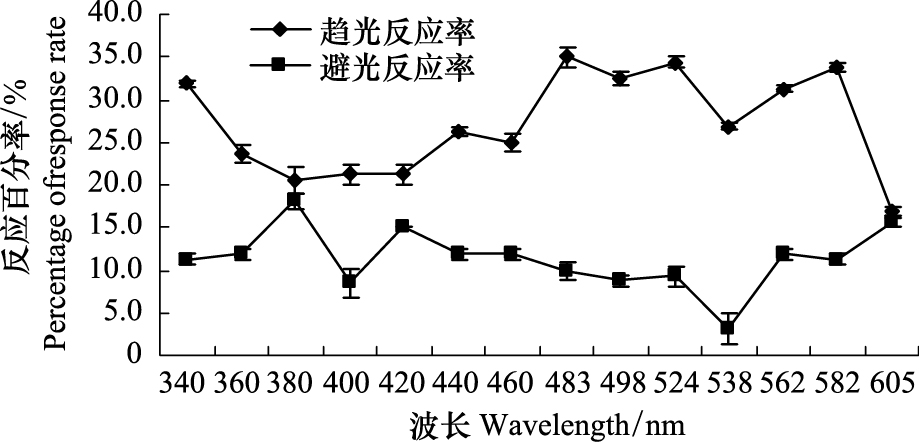
|
| 图 2 棕榈蓟马雌成虫趋、避光的光谱行为曲线 Fig.2 Spectral response curves Thrips palmi female adult of phototaxis and photophobism behavior |
趋光行为反应曲线中,蓝光区483 nm、绿光区498—524 nm、绿光区562—582 nm、紫外光区340 nm棕榈蓟马雌成虫趋光性均较高,趋光率分别达到34.96%、32.48%—34.36%、31.24%—33.74%和31.87%,该4波段间其雌成虫的趋光率无显著差异,但均显著高于其它波段。在橙光区605 nm棕榈蓟马雌成虫的趋光性最低,趋光率仅为16.86%,显著低于其它波段处理。其它波长亦能引起棕榈蓟马雌成虫的趋光反应,趋光率为20.49%—26.87%。结果显示:波长因素对棕榈蓟马雌成虫趋光行为影响较大,不同波段单色光部分存在显著差异,其光感受器类型可能包括绿光、蓝光和紫外光3种。
2.1.2 避光行为避光行为曲线中,棕榈蓟马雌成虫在紫外光区380 nm、橙光区605 nm、紫光区420 nm各有一个峰,其避光率分别达18.08%、15.61%、15.06%,3波段间避光率无显著差异;在绿光区538 nm波段棕榈蓟马雌成虫避光率最低,仅为3.08%,显著低于其它处理;其它波长单色光亦能引起其避光反应,反应率相对较低,且大部分单色光间无显著差异。
2.2 光强度行为反应选取光谱趋光行为试验中棕榈蓟马雌成虫趋光率较高的单色光(340、483、524、582 nm)和避光率较高的单色光(380、605 nm)以及白光,分别用不同光强度水平对其进行光照处理。结果显示:光强度对棕榈蓟马雌成虫趋光行为反应率有较大影响,对避光行为反应率亦有一定影响(图 3,图 4,图 5,图 6,图 7,图 8,图 9)。
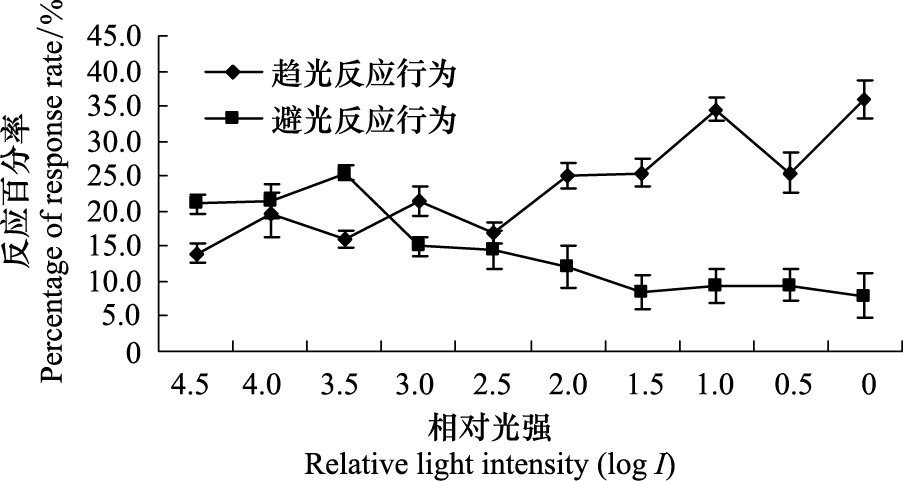
|
| 图 3 白光刺激下棕榈蓟马雌成虫趋、避光行为反应 Fig.3 Intensity-behavior response cures of Thrips palmi female adult on white light |

|
| 图 4 340nm光刺激下棕榈蓟马雌成虫趋、避光行为反应 Fig.4 Intensity-behavior response cures of Thrips palmi female adult on the monochromatic light of 340nm |
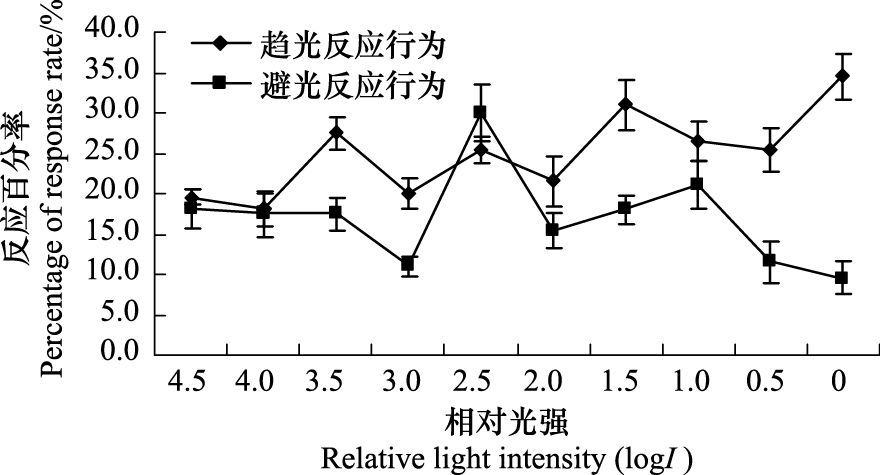
|
| 图 5 380nm光刺激下棕榈蓟马雌成虫趋、避光行为反应 Fig.5 Intensity-behavior response cures of Thrips palmi female adult on the monochromatic light of 380nm |
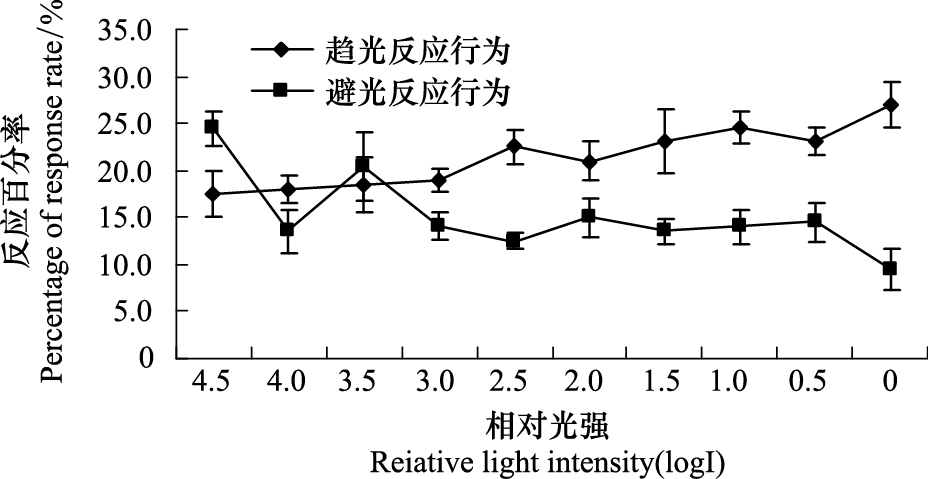
|
| 图 6 483nm光刺激下棕榈蓟马雌成虫趋、避光行为反应 Fig.6 Intensity-behavior response cures of Thrips palmi female adult on the monochromatic light of 483nm |
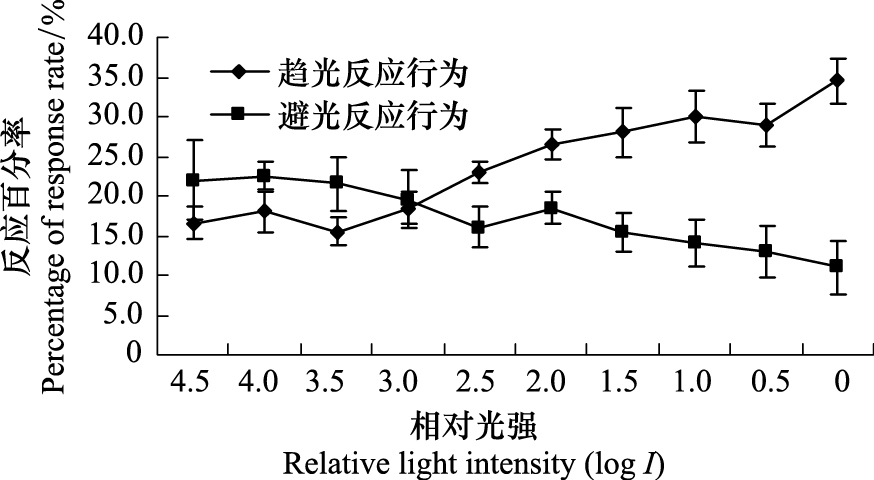
|
| 图 7 524nm光刺激下棕榈蓟马雌成虫趋、避光行为反应 Fig.7 Intensity-behavior response cures of Thrips palmi female adult on the monochromatic light of 524nm |
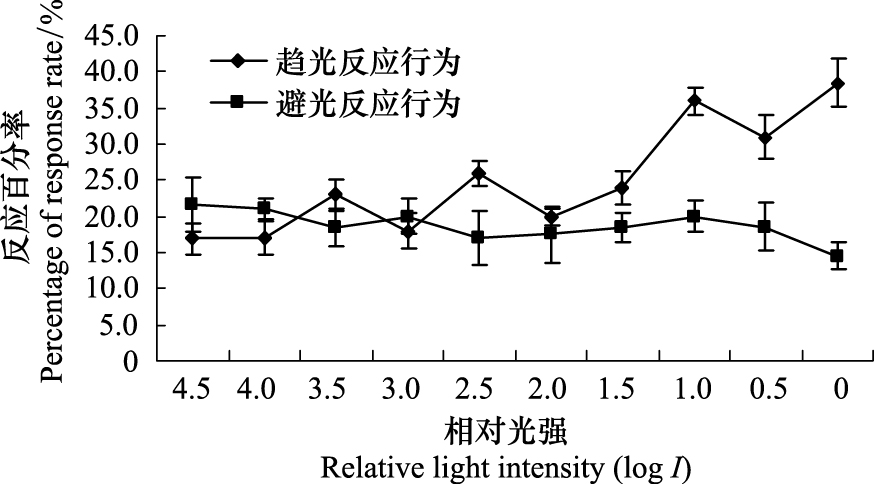
|
| 图 8 582nm光刺激下棕榈蓟马雌成虫趋、避光行为反应 Fig.8 Intensity-behavior response cures of Thrips palmi female adult on the monochromatic light of 582nm |
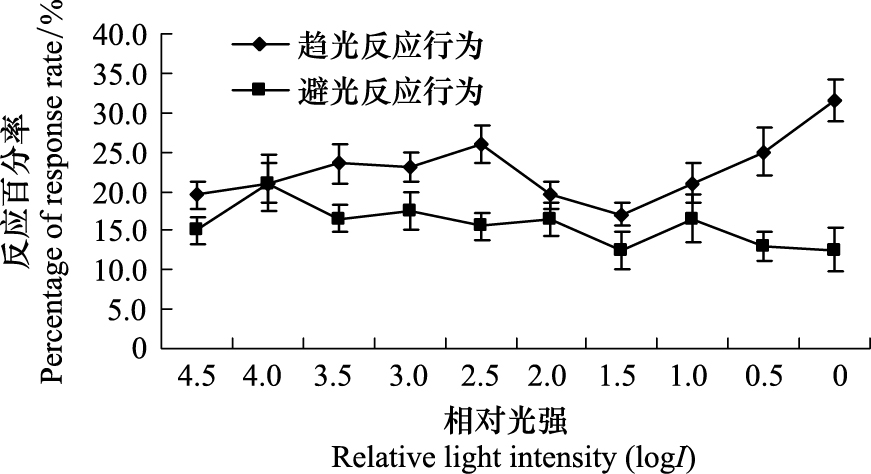
|
| 图 9 605nm光刺激下棕榈蓟马雌成虫趋、避光行为反应 Fig.9 Intensity-behavior response cures of Thrips palmi female adult on the monochromatic light of 605nm |
在测定单色光和白光下,棕榈蓟马雌成虫的趋光反应率总体上随光强增强提高,但在不同单色光下,其趋光行为的变化特点不同:
在白光、380、582 nm单色光下(图 3,图 5,图 8),其雌成虫的光强度趋光行为曲线呈多峰值的锯齿状(趋光率分别为14.00%—36.00%、18.00%—34.50%、17.00%—38.50%);在340、483、524 nm单色光下(图 4,图 6,图 7),其光强度趋光行为曲线均大致呈一直线(趋光率分别为15.50%—26.50%、17.50%—27.00%、15.50%—34.50%);在605 nm单色光下(图 9),棕榈蓟马雌成虫的趋光性呈横“N”字型:在log4.5—2.5下呈上升的直线(趋光率19.50%—26.00%),在log2.5—1.5下则成下降趋势(趋光率26.00%—17.00%),在log1.5—0下又呈上升直线(趋光率17.00%—31.50%)。
在测定单色光、白光下,既使在光强最弱条件下,棕榈蓟马雌成虫仍有一定趋光率,光强最高时亦未出现高端平台。结果显示,光强度对棕榈蓟马雌成虫趋光行为反应影响较大,其影响大小视波长而定,另一方面也表明其雌成虫复眼可感受更弱和更强的光强环境,具有相当强的光强度自调节能力。
2.2.2 避光行为的光强度行为反应在白光和大部分单色光下,棕榈蓟马雌成虫的避光反应率随光强的增强而降低,但在不同单色光下,其避光行为特点在不同光强下略有不同:
在白光、524、582、605 nm单色光下(图 3,图 7,图 8,图 9),棕榈蓟马雌成虫的避光反应曲线近似呈直线,仅在部分光强下略有波动(避光率分别为25.50%—8.00%、22.50%—11.00%、21.50%—14.50%、21.00%—12.50%);在483 nm单色光下(图 6),棕榈蓟马雌成虫的避光曲线在log4.5—log3.5波动较大(趋光率24.50%—13.50%),log3.5—log0则呈近似的直线(趋光率20.50%—9.50%);在340 nm单色光下(图 4),棕榈蓟马雌成虫的避光性大致呈“⌒”形:在log4.5—3.0下呈上升的直线(避光率16.00%—25.50%),在log3.0—2.0下则成水平状态(避光率25.00%—25.50%),在log2.0—0下又呈下降直线(避光率25.50%—13.50%);在380 nm单色光下(图 5),棕榈蓟马雌成虫的避光曲线波动最大:分别在log2.5、log1.0出现两个峰(趋光率30.00%、21.00%),其不同光强下的避光率为30.00%—9.50%。
在测定单色光、白光下,既使在光强最弱条件下,棕榈蓟马雌成虫仍有一定避光率,光强度对棕榈蓟马雌成虫避光行为反应有一定影响,其影响大小因波长而异,进一步表明其雌成虫复眼可感受更弱和更强的光强环境,具有光强度自调节能力。
3 结论与讨论Song J H等、陈华平等研究发现,棕榈蓟马对蓝光有较好的趋性,且蓝色、蓝绿色粘卡对田间棕榈蓟马成虫具有较好的诱捕作用[25, 27]。本研究发现,棕榈蓟马雌成虫对340—605 nm波谱内的14个单色光趋向反应明显不同,在340、483、498、524、562、582 nm等处趋向率较高,表明棕榈蓟马雌成虫光感受器类型可能包括绿光、蓝光和紫外光3种,其中蓝色光区表现出的峰值与Song J H和陈华平等人研究结果一致;但在陈华平的研究结果同时表明,绿色色板与黄色、深蓝色、桔黄色、红色、黑色等色板的诱虫量均较低,色板间无差异,与本研究结果存在一定差异,这可能与与试验小环境内植被颜色造成的背景色有关,或者色板反射波长与单色光波长之间有差异相关,有待于对不同生境下棕榈蓟马雌成虫的趋色、光进行比较研究。范凡研究结果表明,西花蓟马在524、380、498 nm等单色光下趋光率较高,在440、420、340 nm单色光下避光率较高[30],本研究结果与之略有不同,是由于试验误差还是2种蓟马由于长期的生境、习性的细微差异而引起的光敏感性存在一定差异,有待于通过试验进一步验证。
大部分昆虫对光强度有自我调节适应机制。在田间颜色诱集试验中发现,同种颜色深浅的变化对西花蓟马诱集效果不同[27],而在光强度行为反应试验中也表现出同一波长单色光下,随光强度变化西花蓟马趋光反应率产生变化[30],这些都说明了西花蓟马的复眼对光强度有较强的自调节及适应机制,对不同强度的光色能做出相应的选择。本研究表明,特定波长单色光不同光强度下棕榈蓟马雌成虫的趋光反应率、避光反应率不同,说明其雌成虫复眼对光强度具有较强的自我调节及适应机制,对不同强度的光色能做出相应的选择;既使光强较弱时,棕榈蓟马雌成虫的趋光率、避光率仍较高,进一步表明其复眼对光敏感并且有较高的光强度调节能力。本研究结果与西花蓟马的光强行为反应基本相一致,表明昆虫近似种之间行为相近,同时与它们相近生境、习性有较大关系。
本试验结果表明,棕榈蓟马雌成虫对不同单色光有明显的选择性,据此可对田间诱集色板进行改进或研发相应波长的诱捕光源,以更好地对棕榈蓟马进行准确的预测预报和诱集捕杀。
致谢: 本研究得到河北农业大学植保学院魏国树教授、范凡博士的帮助,谨致谢意。
| [1] | 张维球. 农业昆虫学. 北京: 中国农业出版社, 1990: 556-561. |
| [2] | Kato K, Hanada K, Kameya-Iwaki M. Melon yellow spot virus: A distinct species of the genus Tospovirus Isolated from Melon. Phytopathology, 2000, 90(4): 422-427. |
| [3] | Hirose Y, Kajita H, Takagi M, Okajima S, Napompeth B, Buranapanichpan S. Natural enemies of Thrips palmi and their effectiveness in the native habitat, Tailand. Biological Control, 1993, 3(1): 1-5. |
| [4] | Cannon R J C, Matthews I, Collins D W. A review of the pest status and control options for Thrips palmi. Crop Protection, 2007, 26(8): 1089-1098. |
| [5] | Kajita H, Hirose Y, Takagi M, Takagi O, Masami T, Okajima S, Napompeth B, Buranapanichpan S. Host plants and abundance of Thrips palmi Karny (Thysanoptera: Thripidae), an important pest of vegetables in southeast Asia. Applied Entomology and Zoology, 1996, 31(1): 87-94. |
| [6] | 张维球. 广东蔬菜常见蓟马种类及为害情况调查. 昆虫知识, 1976, 3: 83-85. |
| [7] | 易齐, 梁上英. 北京市朝阳区保护地蔬菜上发现棕榈蓟马为害. 植保技术与推广, 2001, 21(3): 29-29. |
| [8] | 秦玉洁, 梁广文, 吴伟坚. 节瓜蓟马的发生危害和防治策略. 植物保护, 2002, 28(4): 21-22. |
| [9] | Yadav R, Chang N T. Temperature-dependent development and life table parameters of Thrips palmi (Thysanoptera: Thripidae) on eggplant. Applied Entomology and Zoology, 2012, 47(4): 301-310. |
| [10] | Park C G, Kim H Y, Lee J H. Parameter estimation for a temperature-dependent development model of Thrips palmi Karny (Thysanoptera: Thripidae). Journal of Asia-Pacific Entomology, 2010, 13(2): 145-149. |
| [11] | Huang L H, Chen C N. Temperature effect on the life history traits of Thrips palmi Karny Thysanoptera: Thripidae on eggplant leaf. Plant Protection Bulletin (Taipei), 2004, 46(2): 99-111. |
| [12] | 贝亚维, 顾秀慧, 高春先, 陈华平. 温度对棕榈蓟马生长发育的影响. 浙江农业学报, 1996, 8(5): 312-315. |
| [13] | 吴佳教, 张维球, 梁广文. 温度对节瓜蓟马发育及产卵力的影响. 华南农业大学学报, 1995, 16(4): 14-19. |
| [14] | Stephens A E A, Dentener P R. Thrips palmi-Potential survival and population growth in New Zealand. New Zealand Plant Protection, 2005, 58: 24-30. |
| [15] | Cabrera-Asencio I. Population dynamics of Thrips palmi (K.) on eggplant and pepper. Journal of Agriculture of the University of Puerto Rico, 1998, 82(3/4): 217-220. |
| [16] | 何成兴, 郭志祥, 浦恩堂, 吴文伟, 尹可锁, 张荣胜, 沈文武, 罗雁婕. 蔬菜棕榈蓟马种群动态及其防治技术研究. 云南大学学报, 2008, 30 (S1): 116-119. |
| [17] | 顾秀慧, 贝亚维, 高春先, 陈华平. 棕榈蓟马在茄子上的种群增长、分布和抽样技术研究. 应用生态学报, 2000, 11(6): 866-868. |
| [18] | Cho K, Kang S H, Lee G S. Spatial distribution and sampling plans for Thrips palmi (Thysanoptera: Thripidae) infesting fall potato in Korea. Journal of Economic Entomology, 2000, 93(2): 503-510. |
| [19] | 何成兴, 郭志祥, 陈艳秋, 杨珺, 浦恩堂, 尹可锁, 吴文伟, 杨丽芳, 李卫东, 罗雁婕. 蔬菜棕榈蓟马空间分布及聚集成因分析//云南省昆虫学会2009年年会论文集. 云南: 云南省昆虫学会, 2009: 119-121. |
| [20] | 刘奎, 王英. 苦瓜棕榈蓟马空间格局及抽样技术研究. 广西植保, 2000, 13(4): 10-12. |
| [21] | Hsu J C, Feng H T, Huang Y J. Susceptibility of Thrips palmi to insecticides recommended in Taiwan. Formosan Entomologist, 2002, 22(1): 83-93. |
| [22] | Kawai A. Population management of Thrips palmi Karny. Japanese Journal of Applied Entomology and Zoology, 2001, 45(2): 39-59. |
| [23] | Seal D R. Management of melon thrips, Thrips palmi Karny (Thysanoptera: Thripidae) using various chemicals//Proceedings of the 118th Annual Meeting of the Florida State Horticultural Society. Florida: Florida State Horticultural Society, 2005, 118: 119-124. |
| [24] | Sreekanth M, Sriramulu M, Rao R D V J P, Babu B S, Babu T R. Evaluation of certain new insecticides against Thrips palmi (Karny), the vector of peanut bud necrosis virus (PBNV) on mungbean (Vigna radiata L. Wilczek). International Pest Control, 2004, 46(6): 315-317. |
| [25] | Song J H, Han H R, Kang S H. Color preference of Thrips palmi Karny in vinylhouse cucumber. Rda Journal of Crop Protection, 1997, 39(2): 53-56. |
| [26] | 李人柯. 菜喜防治节瓜蓟马田间药效试验. 长江蔬菜, 2000, (4): 16-17. |
| [27] | 陈华平, 贝亚维, 顾秀慧, 高春先. 棕榈蓟马(Thrips palmi)对不同颜色粘卡的嗜好及其蓝色粘卡诱虫量的研究. 应用生态学报, 1997, 8(3): 335-337. |
| [28] | 吴建辉, 林莉. 10%除尽悬浮剂防治节瓜蓟马田间药效试验. 广东农业科学, 2008, (2): 63-64. |
| [29] | 牟吉元, 徐洪富, 荣秀兰. 普通昆虫学. 北京: 中国农业出版社, 1996: 363-365. |
| [30] | 范凡, 任红敏, 吕利华, 张莉萍, 魏国树. 光谱和光强度对西花蓟马雌虫趋光行为的影响. 生态学报, 2012, 32(6): 1790-1795. |
| [31] | Matteson N, Terry I, Ascoli-Christensen A, Gilbert C. Spectral efficiency of the western flower thrips, Frankliniella occidentalis. Journal of Insect Physiology, 1992, 38(6): 453-459. |
| [32] | Yudin L S, Mitchell W C, Cho J J. Color preference of thrips (Thysanoptera: Thripidae) with reference to aphids (Homoptera: Aphididae) and leafminers in hawaiian lettuce farms. Journal of Economic Entomology, 1987, 80(1): 51-55. |
| [33] | Vernon R S, Gillespie D R. Spectral responsiveness of Frankliniella oceidentalis (Thysanoptera: Thripidae) determined by trap catches in greenhouses. Environmental Entomology, 1990, 19(5): 1229-1241. |
| [34] | 肖长坤, 郑建秋, 师迎春, 胡铁军, 李文明. 西花蓟马对不同颜色粘卡的嗜好及其诱虫效果. 植物检疫, 2007, 21(3): 155-157. |
| [35] | Wu Q J, Xu B Y, Zhang Y J, Zhang Z J, Zhu G R. Taxis of western flower thrips to different colors and field efficacy of the blue sticky cards. Plant Protection, 2007, 33(4): 103-105. |
| [36] | 魏国树, 张青文, 周明牂, 吴卫国. 不同光波及光强度下棉铃虫Helicoverpa armigera (Hübner) 成虫行为反应. 生物物理学报, 2000, 16(1): 89-95. |
 2015, Vol. 35
2015, Vol. 35




